Nonpoint Source: Agriculture
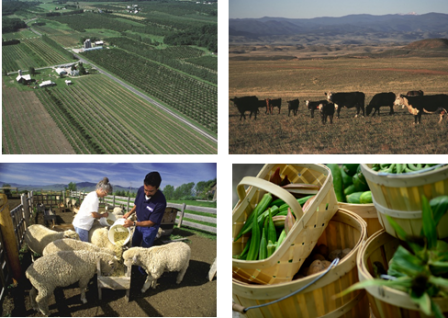 Source: USDA NRCS
Source: USDA NRCS
About half the land area in the United States is farmland. These nearly 1.2 billion acres produce an abundant supply of food and other products. Activities on working farms and ranches can affect water quality, both locally and across multi-state watersheds. Producers can adopt soil and water conservation practices to reduce the runoff of sediment, nutrients, bacteria, pesticides, and other pollutants from their operations.
The links below provide information on how America’s farmers are addressing the challenge of polluted runoff through the National Water Quality Initiative (NWQI) and other approaches.
- What is the extent and importance of U.S. agriculture?
- How do agricultural operations affect water quality?
- What impact does farm runoff have on our inland and coastal waters?
- How do farmers manage their operations to minimize water quality impacts?
- How does the National Water Quality Initiative address agricultural water quality?
What is the extent and importance of U.S. agriculture?
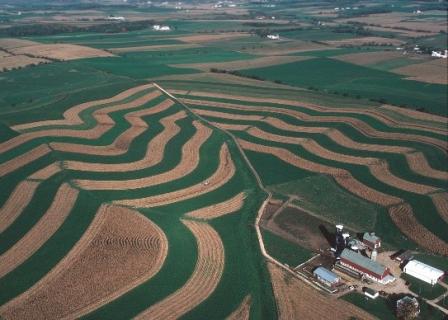 Contour strip cropping reduces erosion and runoff
Contour strip cropping reduces erosion and runoff
(Source: USDA NRCS)Nearly 1.2 billion acres of the nation’s 2.3 billion acres are devoted to agriculture. This includes approximately 330 million acres of row crop land, 655 million acres of pasture and rangeland, and 130 million acres of grazed forestland. Agriculture, food, and related industries contributed over $1 trillion to the U.S. gross domestic product (GDP) in 2017, a 5.4 percent share. The agriculture sector’s overall contribution to GDP is larger than this because agriculture-related sectors rely on agricultural inputs in order to contribute added value to the economy. More than 22 million full- and part-time jobs are linked to the agricultural and food sectors—11 percent of total U.S. employment. Direct on-farm employment accounted for about 2.6 million of these jobs, or 1.3 percent of the national total. The links below provide more information about U.S. agriculture.
Links and Resources
U.S. Department of Agriculture (USDA)
- Economic Research Service: Data on Land Uses in the United States Exit
- Economic Research Service: Data on Agricultural Operations in the United States Exit
- National Agricultural Statistics ServiceExit
How do agricultural operations affect water quality?
Agricultural operations can have significant effects on water quality, due to the extent of farm activities on the landscape, the soil-disturbing nature of those activities, and associated impacts from sediment, nutrients, pesticides, and herbicides. The National Water Quality Assessment shows that agricultural runoff is the leading cause of water quality impacts to rivers and streams, the third leading source for lakes, and the second largest source of impairments to wetlands. About a half million tons of pesticides, 12 million tons of nitrogen, and 4 million tons of phosphorus fertilizer are applied annually to crops in the continental United States. Soil erosion, nutrient loss, bacteria from livestock manure, and pesticides constitute the primary stressors to water quality.
Why? Nutrients in fertilizer and livestock manure, pesticides, and other substances don't always remain stationary on the landscape where they are applied. Runoff, infiltration, and irrigation return flows can move these contaminants into local streams, rivers, and groundwater. Rainfall and snowmelt transport the majority of these pollutants to surface waters, but other factors (e.g., cattle loafing in stream corridors, stream channel erosion) can also degrade water quality.
The effects of this runoff vary widely, depending on the type of operation, landscape conditions, soils, climate, and farm management practices. Increased levels of nitrogen and phosphorus from fertilizer and manure can stimulate algal blooms in lakes and rivers, which can lead to the development of hypoxic (low oxygen) conditions that are harmful to aquatic life. Algae can also affect recreational uses of local streams, downstream reservoirs, and estuaries. Excessive sedimentation from erosion can overwhelm aquatic ecosystems, smother breeding areas, and degrade coastal and marine ecosystems—including coral reefs. Bacteria and nutrients from livestock and poultry manure can cause beach and shellfish bed closures and affect drinking water supplies. Pesticide runoff to streams can pose risks to aquatic life, fish-eating wildlife, and drinking water supplies.
Pollutants from agricultural operations can also enter groundwater and degrade sources of drinking water. Human health impacts might occur as a result. More than 13 million U.S. households obtain their drinking water from private wells. Pollution from pesticides, fertilizers, and animal manure can enter groundwater depending upon local land use and geologic conditions. The links below provide more information on how agriculture can affect water quality.
Links and Resources
Environmental Protection Agency (EPA)
- National Water Quality AssessmentExit
- Potential Well Water Contaminants and Their Impacts
- Report on the Environment
U.S. Centers for Disease Control and Prevention
U.S. Department of Agriculture (USDA)
U.S. Geological Survey (USGS)
What impact does farm runoff have on inland and coastal waters?
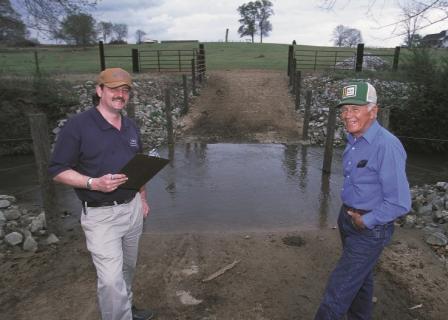 A fenced stream crossing restricts livestock access to a small area and minimizes damage to the stream
A fenced stream crossing restricts livestock access to a small area and minimizes damage to the stream
(Source: USDA NRCS)Nationwide, soil erosion, nutrient loss, and the runoff of pesticides and other contaminants from America’s vast agricultural land base are the leading causes of water quality impairment. The impacts vary widely across the country, depending on farm types, conservation practices, soils, climate, topography, and other local conditions. For example, about 46% of our rivers and streams have excess nutrients, and only 28% are assessed as “healthy” based on their biological communities (see National Rivers and Streams Assessment link below). For lakes, 21% have high levels of algal growth and 39% have measurable levels of a cyanotoxin—a byproduct of certain kinds of bacteria (e.g., blue-green algae). Around 21% of coastal waters have high nutrient levels. Other waters have high levels of sediment and bacteria.
The links below provide detailed information about national and state assessments of the causes and sources of water quality threats and impairments.
Links and Resources
Environmental Protection Agency (EPA)
- Federal–State Mississippi River/Gulf of Mexico Hypoxia Task Force
- National Rivers and Streams Assessment
- How’s My Waterway?
- National Water Quality Inventory Report to Congress
- Nutrient Pollution
- Status of Available State Water Quality Assessment Data
U.S. Geological Survey (USGS)
How do farmers manage their operations to minimize water quality impacts?
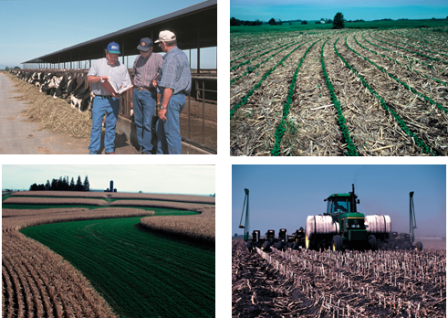 Source: USDA NRCSFertilizer losses from fields, soil erosion, and livestock manure runoff are key considerations for producers that are taking action to improve water quality. Systems of conservation practices, (sometimes called best management practices or BMPs) are linked to the type of operation, landscape conditions, soils, climate, and other farm management activities. These practices include a range of structural and non-structural approaches, including many that are highly effective and relatively low-cost.
Source: USDA NRCSFertilizer losses from fields, soil erosion, and livestock manure runoff are key considerations for producers that are taking action to improve water quality. Systems of conservation practices, (sometimes called best management practices or BMPs) are linked to the type of operation, landscape conditions, soils, climate, and other farm management activities. These practices include a range of structural and non-structural approaches, including many that are highly effective and relatively low-cost.
For example, nutrient runoff is addressed through application management, tailored methods of tillage and drainage, cover crops, and vegetated buffers. Farmers can leave the soil surface undisturbed from harvest to planting (using conservation practices such as no-till or conservation tillage) to reduce runoff, plant cover crops to uptake residual nutrients, and/or maintain vegetated buffer strips around fields and streams to intercept runoff. These tillage and conservation cover practices can also improve soil health by building up organic material over time, which helps retain water and excess nutrients and adds crop residue to the soil surface, protecting it from erosion.
Nutrient management practices include targeting fertilizer and manure application via soil testing, crop-specific calibration, and timing applications to maximize uptake and minimize runoff. Using drip irrigation instead of furrow irrigation decreases the amount of water lost to ditches or evaporation and allows better control of the amounts of pesticides and nutrients added to irrigation water. Storing livestock manure in lagoons, covered stockpiles, or protected upland areas minimizes runoff risks. Even subsurface cropland drainage systems can be managed to lessen pollutant export to streams.
Agricultural conservation is best practiced through a systems approach, where multiple pollutants can be controlled by implementing carefully tailored systems of conservation practices. Ideally, these practices are planned, sited, sized, and implemented to target those areas that have the greatest influence on water quality and related problems (i.e., critical source areas). The links below provide detailed information on these conservation practices.
Links and Resources
Summary and Overview Information on Conservation Practices
Environmental Protection Agency (EPA)
- Agricultural Nutrient Management
- Erosion and Sediment Control for Agriculture
- Grazing Lands Management
- Introduction to Integrated Pest Management
- Irrigation Water Management
- National Management Measures to Control Nonpoint Source Pollution from Agriculture
- Pesticide Management
- Sources and Solutions for Addressing Nutrient Pollution
- Watershed Academy Webinar Agricultural Management Practices for Water Quality Protection
U.S. Department of Agriculture (USDA)
Detailed Technical Information on Conservation Practices
Environmental Protection Agency (EPA)
- Critical Source Area Identification and BMP Selection
- National Management Measures to Protect and Restore Wetlands and Riparian Areas for the Abatement of Nonpoint Source Pollution
U.S. Department of Agriculture (USDA)
- List of NRCS Conservation Practice Standards Exit
- NRCS Field Office Technical Guide for Conservation Practices and Systems Exit
U.S. Forest Service
Other Resources
- Ten Ways to Reduce Nitrogen Loads from Drained Cropland in the Midwest (Illinois Drainage Research and Outreach Program at the University of Illinois) Exit (Summary slides)
Regulatory Requirements, Case Studies, and General Information
Environmental Protection Agency (EPA)
- Agriculture Guidance for Federal Land Management in the Chesapeake Bay Watershed
- Animal Feeding Operations
- Environmental Effects and Regulatory Information on Animal Feeding Operations
- National Agriculture Compliance Assistance Center
U.S. Department of Agriculture (USDA)
- Case Studies and Lessons Learned on Conservation Practice Implementation (How to Build Better Agricultural Conservation Programs to Protect Water Quality: The National Institute of Food and Agriculture–Conservation Effects Assessment Project Experience)Exit
- Conservation Programs in the Federal Farm Bill Exit
- Water and Agriculture Information Center Exit
Other Resources
How does the USDA National Water Quality Initiative address agricultural water quality?
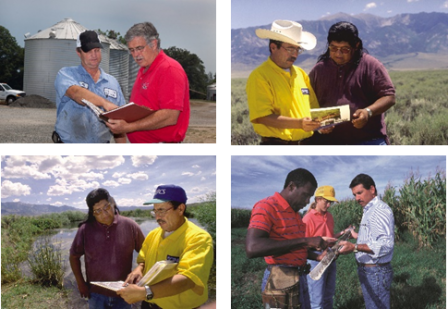 Source: USDA NRCSUSDA NRCS launched the NWQI in 2012 to reduce the runoff of agriculture-related nutrients, sediment, and pathogens in small high-priority watersheds in each state. NWQI is a partnership of NRCS, EPA, and state nonpoint source programs to accelerate voluntary conservation practice adoption to improve water quality using funding from the NRCS Environmental Quality Incentives Program (EQIP), the Clean Water Act Section 319 Program, and other resources. A key part of the NWQI targeting effort includes implementing on-farm conservation systems that avoid, trap, and control runoff in these high-priority watersheds.
Source: USDA NRCSUSDA NRCS launched the NWQI in 2012 to reduce the runoff of agriculture-related nutrients, sediment, and pathogens in small high-priority watersheds in each state. NWQI is a partnership of NRCS, EPA, and state nonpoint source programs to accelerate voluntary conservation practice adoption to improve water quality using funding from the NRCS Environmental Quality Incentives Program (EQIP), the Clean Water Act Section 319 Program, and other resources. A key part of the NWQI targeting effort includes implementing on-farm conservation systems that avoid, trap, and control runoff in these high-priority watersheds.
Water quality monitoring plays a critical role in the NWQI. States monitor water quality in a subset of NWQI watersheds. The objective of NWQI instream monitoring is to assess whether water quality and/or biological conditions related to nutrients, sediments, or pathogens from livestock has changed in the watershed. The links below provide detailed information on NWQI and how it operates.
Links and Resources
Environmental Protection Agency (EPA)
- 2014 Guidance Memorandum on NWQI Monitoring
- Watershed Academy Webcast on the NWQI (July 10, 2012)
- Webinar—NRCS-EPA NWQI: Water Quality Monitoring and Data Sharing Agreements (September 11, 2013)Exit
- Webinar—Watershed Planning from an NWQI Perspective (April 25, 2017) Exit
- Webinar Slides—EPA / State Approach to Instream Monitoring for NWQI (April 30, 2013); webinar transcript
- Webinar Slides—Water Quality Monitoring for NWQI Watershed Projects (July 18, 2013); webinar transcript
U.S. Department of Agriculture (USDA)
